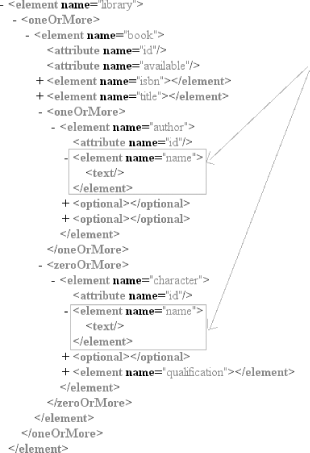Chapter 5. Flattening the First Schema
If you look at the structure of the Russian doll-style
schema, you’ll see that it
follows the structure of the instance document it applies to, as
shown in Figure 3-1. Writing the first
schema has pretty much been limited to inserting
text, element, or
attribute elements into the schema each time a
text node, element, or attribute was encountered in the instance
document. This method of creating schemas can be seen as a
serialization of the XML infoset
(i.e., of the structure available in the document) and could,
therefore, be easily automated.
Tip
Automated serialization is the principle behind Examplotron, a program described in Chapter 14.
There are a couple of drawbacks to modeling documents with the Russian doll-style schemas, however. First, they aren’t modular and therefore become difficult to read and maintain when documents are large or complex. Second, they can’t represent recursive (self-referencing) models. (Lists that may themselves contain lists are a common case of this model.)
The lack of modularity can be seen in a document as simple as the
first schema, shown in Example 3-1.
There’s a name element that uses
the same model within both the character and
author elements.
Figure 5-1 shows how, in the first schema, you need
to give the definition of what name means in each
context:
 |
Get RELAX NG now with the O’Reilly learning platform.
O’Reilly members experience books, live events, courses curated by job role, and more from O’Reilly and nearly 200 top publishers.

